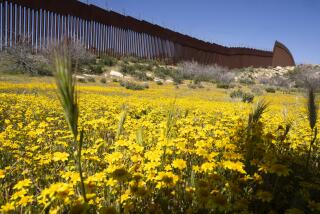All the world’s an island
- Share via
BARRO COLORADO ISLAND, PANAMA — High on a jungle hilltop, at a unique research center in the middle of the Panama Canal, scientists are studying three-toed sloths, howler monkeys and jungle flora to better understand evolution and the practical effects of global warming.
The biological secrets being studied at the Smithsonian Tropical Research Institute are more than just thesis fodder. Scientists say some provide clear warnings of a planet in peril and could provide clues to ways to save it.
Barro Colorado Island was formed in 1911 when the Chagres River was dammed to help create the Panama Canal. The flooding formed an isolated refuge for thousands of plant and animal species.
The Smithsonian set up shop here in 1923, when the canal was under the control of the United States. Its continued existence was assured through the terms of the canal’s transfer to Panama in 1999. Now, an average 300 biologists a year from 15 countries use STRI’s uniquely self-contained ecosystem to study animal and plant life.
“It’s a precious jewel of tropical biological research,” said Kate Milton, a UC Berkeley zoologist who has studied howler monkeys here for 30 years.
One project underway that has borne perhaps the most dramatic results is a study of rain forest trees native to the region, led by Harvard botanist Stuart Davies. Early results show that rising temperatures cause trees to grow more slowly. As a consequence, they absorb less carbon dioxide and release less oxygen into the atmosphere, a worrisome upshot of global warming.
Milton says her research on the primates’ eating habits has underscored the vitamin D deficiency in the human diet “compared with our wild primate relatives.”
The deficiency, caused in part by low consumption of fruits and vegetables, could be contributing to cancer, obesity, osteoporosis and other maladies.
“Our modern Western diet has gotten us off track in terms of our health,” Milton said in a telephone interview from Berkeley.
Research here took a qualitative leap forward in 2004, when STRI installed an electronic tracking system that scientists use to monitor the movements, heartbeats and brain waves of resident wild animals, including ocelots, toucans, bats and agoutis, a rodent species.
The system consists of seven 10-story radio towers with which scientists track native animals outfitted with electronic gadgetry.
Niels Rattenborg, a scientist at Max Planck Institute for Ornithology in Starnberg, Germany, used the system in collaborating on a study of three-toed sloths’ sleep habits. (Contrary to his expectations, sloths in the wild averaged several hours less sleep than those in zoos.)
“Sleep is good for human beings. We perform poorly if we are deprived of it,” said Rattenborg, who this year will clock the snooze patterns of ostriches in South Africa. “If we can look at animals and see what purpose sleep is serving, we can formulate help or treatments for people with insomnia.”
Tracking systems that use tiny microphones also are helping Bolivian biologist Kathrin Barbosa measure the radar-like signals that foraging fruit bats send out to help them identify and locate insects for food.
Studying bats -- Panama is home to 200 species -- may help the environment because they control insects and other pests, she said. And though bats were used to help develop radar, many details of how they communicate remain a mystery; gaining understanding could someday lead to further breakthroughs.
“STRI is an ideal location to study them because it offers all the necessary conditions: It’s comfortable, has the necessary facilities, and I can work with other global authorities,” Barbosa said.
University of Georgia biologist Robert Horan is here researching tree frogs, which are dying of fungal infections at alarming rates throughout Central America, a fact that he said should be worrisome to the public at large.
“A frog dies and people say, so what? But if that frog eats mosquitoes that cause yellow fever, maybe it’s better to find out what the frog’s role in the ecosystem is before they all disappear,” Horan said.
--






